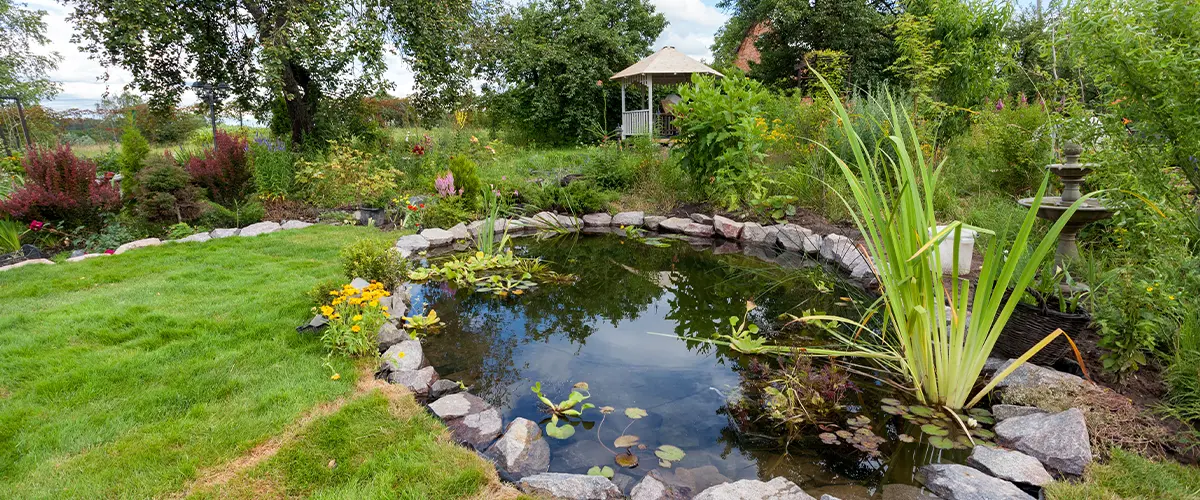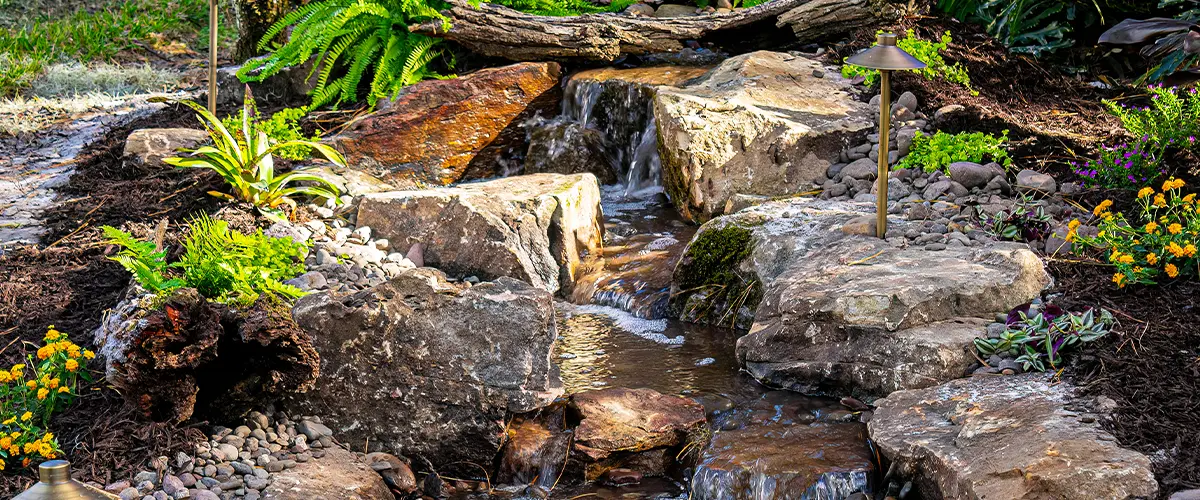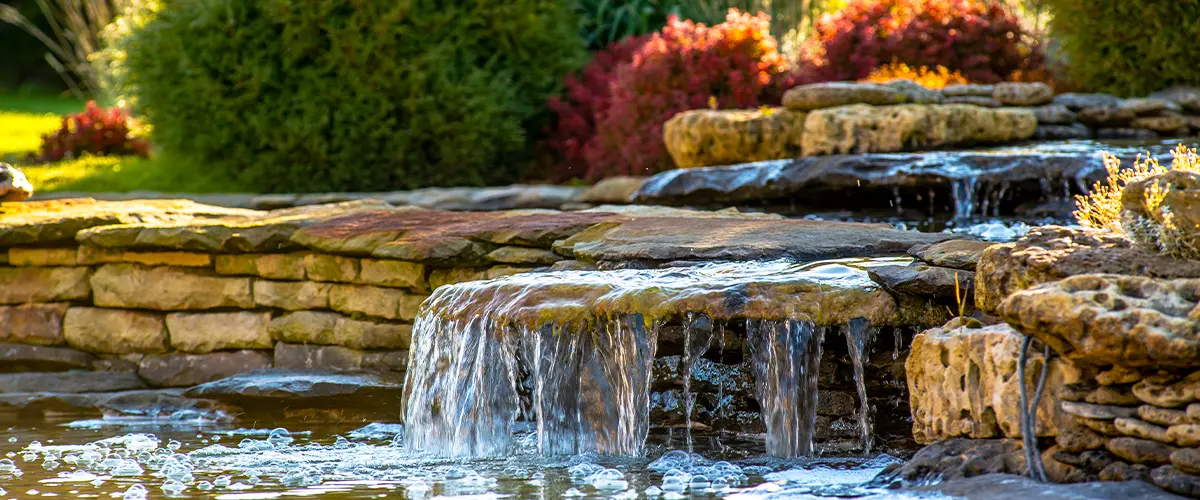Pondless Waterfall Vs Traditional Pond: A Comprehensive Comparison
Deciding between a pondless waterfall and a traditional pond for your garden or patio can be challenging, as both options offer unique benefits. Each has its own set of features, from the serene beauty of a traditional pond to the modern simplicity of a pondless waterfall.
In this guide, we’ll break down the pros and cons of each, focusing on key aspects like maintenance, safety, aesthetics, and cost to help you determine which option is the best fit for your outdoor space.

Definition and Key Features
Traditional ponds feature standing water and are generally inhabited by fish, whereas pondless waterfalls consist of a recirculating waterfall and stream without a pond.
The key features of traditional ponds include creating a habitat for fish and aquatic plants, while the distinguishing characteristic of pondless waterfalls is the absence of standing water, making them safe for children and pets.
Traditional Pond
A traditional pond is a water feature with still or gently moving water, often home to fish and plants. People love adding ponds to their gardens because they can bring nature closer.
You can see birds coming for a drink or frogs jumping around. It’s like having a bit of wildlife in your own backyard. Ponds need a bit more space compared to pondless waterfalls.
Ponds have parts you need to take care of: the water, the fish if you have them, and the plants.
Keeping the water clean is important so everything living there stays healthy. This means sometimes you have to remove leaves or add more water if it gets too low.
It’s not just about looks; it’s making sure the ecosystem in your pond thrives. Creating a traditional pond brings life and tranquility right into your garden.
Pondless Waterfall
A pondless waterfall is a water feature without a visible pool of water at the bottom. Water flows over rocks or through gravel, disappearing into a hidden underground reservoir. This type makes maintenance easier and safer than traditional ponds.
You don’t have to clean a big pool of water or worry about animals falling in.
People like pondless waterfalls because they fit in small spaces. They use less water, too. You can put one in your garden and enjoy the sound of running water without needing much room.
They cost less at first and over time compared to bigger ponds with fish or plants.

Maintenance and Safety Aspects
Maintenance Requirements
Maintaining a traditional pond or a pondless waterfall is key to their longevity and appeal. Each type demands particular care routines.
For a traditional pond:
- Clean the pump filter weekly to ensure water flows smoothly.
- Check and balance water chemistry monthly, focusing on pH levels.
- Remove debris like leaves and twigs from the water regularly to prevent decay.
- Trim plants around the pond to keep them healthy and prevent overgrowth in the water.
- Add beneficial bacteria to break down organic waste, enhancing water clarity.
- Control algae growth through chemical treatments or UV filters as needed.
For a pondless waterfall:
- Inspect the pump monthly since it's the heart of the waterfall's circulation system.
- Clear away any debris in the basin area to maintain efficient water flow.
- Check for leaks in the liner periodically, especially after harsh weather conditions.
- Clean out pre-filter mats or screens to prevent clogging of the system’s mechanics.
- Adjust rocks and gravel annually to secure proper placement for optimal water flow.
Safety Considerations
Creating a safe environment around water features is crucial for preventing accidents. Both traditional ponds and pondless waterfalls pose risks, especially to small children or pets.
Safety measures such as securing the area with fencing, adding netting to cover the water surface in ponds, and using non-slip materials around wet areas are essential. Moreover, installing alarms or motion sensors can provide an added layer of security.
According to research by the Centers for Disease Control and Prevention (CDC), drowning is a leading cause of injury-related death among young children ages 1 to 4 years old. Therefore, implementing safety precautions around these water features should be a top priority for homeowners looking to add them to their outdoor spaces.
Understanding and addressing potential hazards associated with both options can ensure the enjoyment of these beautiful additions without compromising on safety.
Safety first! Prioritizing safety measures ensures peace of mind when enjoying your outdoor space.

Aesthetic and Functional Differences
Traditional ponds offer a serene, still water feature where aquatic plants and fish can thrive, while pondless waterfalls provide the dynamic movement of cascading water over rocks, creating a mesmerizing sight and soothing sound for any outdoor space.
Each option brings its own unique blend of visual appeal and practical functionality to your landscape.
Visual Appeal
Traditional ponds provide a classic and serene look to the landscape, often becoming a focal point in the garden. The combination of still water, aquatic plants, and possibly fish creates a tranquil and picturesque setting.
On the other hand, pondless waterfalls offer an elegant and natural appearance with cascading water that adds movement and sound to the environment. They can be designed in various styles, from small rock features to larger multi-tiered falls, providing a visually dynamic element to outdoor spaces.
The choice between these two options ultimately depends on personal preference as traditional ponds offer a peaceful atmosphere with their calm waters while pondless waterfalls bring movement and soothing sounds through flowing water.
Both designs have the potential to enhance visual appeal but cater to different aesthetic tastes.
Water Management
Transitioning from visual appeal to water management, it’s important to understand the distinct differences in how these two water features are managed. Traditional ponds require careful monitoring and balancing of pH levels, oxygenation, and algae control to maintain a healthy ecosystem for fish and plants.
On the other hand, pondless waterfalls involve recirculating water through an underground reservoir, which minimizes evaporation and eliminates the need for frequent refilling.
In traditional ponds, regular maintenance like cleaning filters and skimming debris is necessary to keep the water clear and algae-free. In contrast, pondless waterfalls have simpler maintenance requirements due to their self-contained systems, requiring minimal upkeep beyond occasional debris removal.
It’s worth considering these differences in managing both options when deciding which best aligns with your needs and lifestyle.
Environmental and Cost Implications
Ecosystem Impact
The establishment of a traditional pond can significantly impact the ecosystem. These ponds often necessitate chemicals to maintain water quality, which can harm aquatic life and nearby flora.
Moreover, the excavation process for traditional ponds disrupts the natural landscape and habitat for various organisms. Conversely, pondless waterfalls have a lower ecosystem impact due to their self-contained nature.
They do not require harmful chemicals and can be integrated into existing landscapes with minimal disruption.
Additionally, traditional ponds often introduce non-native species that can outcompete or prey on local wildlife, further disrupting the balance of the ecosystem. In contrast, pondless waterfalls do not pose this threat since they do not provide a permanent aquatic environment for potentially invasive species to thrive.
Thus, when considering the ecosystem impact, it is evident that pondless waterfalls are more environmentally friendly compared to traditional ponds.
Initial and Ongoing Costs
| Feature | Traditional Pond | Pondless Waterfall |
|---|---|---|
| Initial Setup Cost | Higher due to excavation, liner, pumps, and ecosystem components. | Lower as it requires less material and labor. |
| Ongoing Maintenance Costs | Can be high; regular cleaning, water treatment, and electricity for pumps add up. | Lower; less frequent maintenance and lower operating costs. |
| Cost Impact Factors | Size, depth, and choice of aquatic plants and fish. | Size of the waterfall and length of the stream. |
| Estimated Annual Maintenance Cost | $250 to $500, varies by size and complexity. | $100 to $200, primarily for pump operation and occasional cleaning. |

pondless waterfall vs traditional pond - FAQs
Conclusion
When choosing between a pondless waterfall and a traditional pond, it’s essential to weigh factors like ease of maintenance, safety, visual appeal, and environmental impact. Both options can elevate your landscape, offering distinct advantages depending on your needs and lifestyle.
Whether you’re drawn to the timeless tranquility of a traditional pond or the low-maintenance allure of a pondless waterfall, making an informed decision will ensure your outdoor space reflects your vision.
Ready to transform your garden? Contact Site Pros Landscaping today to start designing the perfect water feature for your home! (407) 480-0713
